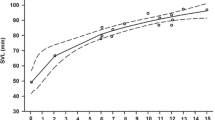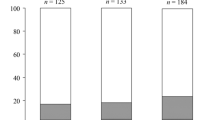Abstract
Studies on the sex-age structure in a population of the multi-colored lizard (Eremias arguta deserti Gmelin 1788) was carried out at the level of the elementary intrapopulation group. The area of research was the sandy semi-deserts near the village Dosang, Astrakhan region. The definition of the groups was based on observations of the behavior, published information about the sex-age structure of the species confirmed by literature data on the autopsy of animals, and a statistical analysis. The data obtained show the presence of five sex-age groups in the spring population: immature individuals, half-adult males and females, and two-year-old mature males and females. In addition, according to their size, there were animals possibly older than two years, but they were singular. The September population of the multicolored lizard was likewise divided into five age groups: juveniles, half-adult individuals of both sexes, and a small number of one-year-old mature individuals of both sexes. The autumn intra-population group was not numerous, because by that time most of the adult animals had gone into hibernation. In spring, the group of semi-adult lizards was 7.2 times smaller than that of adults. In autumn, the number of juveniles was 2.1 times higher than in adults. In spring, the sex ratio among the adult animals was close to 1 : 1. Among semi-adults, females predominated numerically both in spring and autumn.
Similar content being viewed by others
REFERENCES
Badmaeva, V.I., Reproduction of steppe-runner (Eremias arguta) on the territory of the Kalmyk ASSR, in Gerpetologiya (Herpetology), Krasnodar: Kuban. Univ., 1976, pp. 114–117.
Badmaeva, V.I., Lizards of Kalmykia, Extended Abstract of Cand. Sci. (Biol.) Dissertation, Kiev, 1983.
Chernov, S.A., Ecological and faunistic survey of reptiles in the south of the Volga-Ural interfluve, Tr. Zool. Inst. Akad. Nauk SSSR, 1954, vol. 16, pp. 137–158.
Galán, P., Structure of a population of the lizard Podarcis bocagei in northwest Spain: variations in age distribution, size distribution and sex ratio, Anim. Biol., 2004, vol. 54, no. 1, pp. 57–75.
Karaseva, E.V., Tagging of terrestrial mammals in the USSR, Byull. Mosk. O-va Ispyt. Prir., Otd. Biol., 1955, vol. 60, no. 5, pp. 31–42.
Kireev, V.A., On the study of ecology and biology of the steppe-runner Eremias arguta Palls in Kalmykia, in Zhivotnyi mir Kalmykii, ego okhrana i ratsional’noe ispol’zovanie (The Fauna of Kalmykia, Its Protection and Sustainable Use), Elista, 1977, pp. 70–81.
Kireev, V.A., Amphibians and reptiles of Kalmykia, Extended Abstract of Cand. Sci. (Biol.) Dissertation, Kiev, 1982.
Kotenko, T.I., On the ecology of the multicolored foot-and-mouth disease in the Lower Dnieper region, in Voprosy gerpetologii (Problems of Herpetology), Leningrad: Nauka, 1977, pp. 120–121.
Kotenko, T.I., Steppe-runner Eremias arguta deserti (Reptilia, Sauria) in Ukraine. Communication 1, Vestn. Zool., 1981, no. 4, pp. 15–21.
Kotenko, T.I., Reptiles of the left-bank steppe of Ukraine, Extended Abstract of Cand. Sci. (Biol.) Dissertation, Kiev: Kiev. Gos. Univ., 1983.
Kotenko, T.I., On the records of rare and scarce species of reptiles in Ukraine, in Vsesoyuznoe soveshchanie Raznotsvetnaya yashchurka (All-Union Conference on the Steppe-Runner), Shcherbak, N.N., Ed., Kiev: Naukova Dumka, 1986a, pp. 169–189.
Kotenko, T., Eremias arguta deserti (Reptilia: Sauria) in the Ukraine, in Studies in Herpetology, Prague, 1986b, pp. 479–482.
Kotenko, T.I., (Reptiles of the left-bank steppe of Ukraine, Extended Abstract of Cand. Sci. (Biol.) Dissertation, Kiev, 1983).
Mashkin, V.I., Metody izucheniya okhotnich’ikh i okhranyaemykh zhivotnykh v polevykh usloviyakh: uchebnoe posobie (Methods for Studying Hunting and Protected Animals in the Field: Tutorial), St. Petersburg: Lan’, 2013.
Naumov, N.P., Ekologiya zhivotnykh (Animal Ecology), Moscow: Vysshaya shkola, 1963, 2nd ed.
Okulova, N.M., Some features of the biology of the steppe-runner in Western Kazakhstan, in Voprosy gerpetologii (Problems of Herpetology), Leningrad: Leningrad. Univ., 1964, pp. 50–51.
Shcherbak, N.N., Zemnovodnye i presmykayushchiesya Kryma: Herpetologia Taurica (Amphibians and Reptiles of the Crimea: Herpetologia Taurica), Kiev: Naukova Dumka, 1966.
Shcherbak, N.N., Yashchurki Palearktiki (Lizards of the Genus Eremias of the Palaearctic), Kiev: Naukova Dumka, 1974.
Tertyshnikov, M.F., Ecological analysis and biocenological purpose of the populations of the Russian sand lizard (Lacerta agilis exigua Eichw., 1831) and the steppe-runner (Eremias arguta deserti Gmelin, 1788) in the conditions of the Stavropol Upland, Extended Abstract of Cand. Sci. (Biol.) Dissertation, Kiev, 1972.
Tertyshnikov, M.F., On the reproduction of the Russian sand lizard and the steppe-runner in the Ciscaucasia, Ekologiya, 1978, no. 2, pp. 94–96.
Tertyshnikov, M.F., Development and growth. Population structure, in Raznotsvetnaya yashchurka (The Steppe-Runner), Shcherbak, N.N., Ed., Kiev: Naukova dumka, 1993, рр. 190–194.
Tertyshnikov, M.F. and Gorovaya, V.I., Reptiles of the Stavropol krai. Communication 1. Turtle and lizards, in Fauna Stavropol’ya (Fauna of the Stavropol Region), Stavropol’, 1984, no. 3, pp. 48–91.
ACKNOWLEDGMENTS
This study was carried out based on self-financing within the framework of the initiative theme. The authors are grateful to the students of the Department and the Faculty of Ecology who took part in the collection of field material.
Funding
This study was supported by the Strategic Academic Leadership Program of the Peoples’ Friendship University of Russia.
Author information
Authors and Affiliations
Corresponding authors
Ethics declarations
Conflict of interest. The authors declare that they have no conflict of interest.
Statement on the welfare of animals. All applicable international, national, and/or institutional guidelines for the care and use of animals were followed.
Rights and permissions
About this article
Cite this article
Polynova, G.V., Mishustin, S.S. & Polynova, O.E. Sex-Age Population Structure of the Multicolored Lizard (Eremias arguta deserti, Lacertidae) in Semi-Deserts of Astrakhan Region. Biol Bull Russ Acad Sci 48, 1017–1021 (2021). https://doi.org/10.1134/S1062359021070232
Received:
Revised:
Accepted:
Published:
Issue Date:
DOI: https://doi.org/10.1134/S1062359021070232




